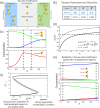Modelling compartmentalization towards elucidation and engineering of spatial organization in biochemical pathways
- PMID: 28935941
- PMCID: PMC5608717
- DOI: 10.1038/s41598-017-11081-8
Modelling compartmentalization towards elucidation and engineering of spatial organization in biochemical pathways
Abstract
Compartmentalization is a fundamental ingredient, central to the functioning of biological systems at multiple levels. At the cellular level, compartmentalization is a key aspect of the functioning of biochemical pathways and an important element used in evolution. It is also being exploited in multiple contexts in synthetic biology. Accurate understanding of the role of compartments and designing compartmentalized systems needs reliable modelling/systems frameworks. We examine a series of building blocks of signalling and metabolic pathways with compartmental organization. We systematically analyze when compartmental ODE models can be used in these contexts, by comparing these models with detailed reaction-transport models, and establishing a correspondence between the two. We build on this to examine additional complexities associated with these pathways, and also examine sample problems in the engineering of these pathways. Our results indicate under which conditions compartmental models can and cannot be used, why this is the case, and what augmentations are needed to make them reliable and predictive. We also uncover other hidden consequences of employing compartmental models in these contexts. Or results contribute a number of insights relevant to the modelling, elucidation, and engineering of biochemical pathways with compartmentalization, at the core of systems and synthetic biology.
Conflict of interest statement
The authors declare that they have no competing interests.
Figures






Similar articles
-
The interplay of spatial organization and biochemistry in building blocks of cellular signalling pathways.J R Soc Interface. 2020 May;17(166):20200251. doi: 10.1098/rsif.2020.0251. Epub 2020 May 27. J R Soc Interface. 2020. PMID: 32453980 Free PMC article.
-
Design Principles for Compartmentalization and Spatial Organization of Synthetic Genetic Circuits.ACS Synth Biol. 2019 Jul 19;8(7):1601-1619. doi: 10.1021/acssynbio.8b00522. Epub 2019 Jul 1. ACS Synth Biol. 2019. PMID: 31257861
-
Toward metabolic engineering in the context of system biology and synthetic biology: advances and prospects.Appl Microbiol Biotechnol. 2015 Feb;99(3):1109-18. doi: 10.1007/s00253-014-6298-y. Epub 2014 Dec 31. Appl Microbiol Biotechnol. 2015. PMID: 25547833 Review.
-
The challenges of cellular compartmentalization in plant metabolic engineering.Curr Opin Biotechnol. 2013 Apr;24(2):239-46. doi: 10.1016/j.copbio.2012.11.006. Epub 2012 Dec 12. Curr Opin Biotechnol. 2013. PMID: 23246154 Review.
-
A structured approach for the engineering of biochemical network models, illustrated for signalling pathways.Brief Bioinform. 2008 Sep;9(5):404-21. doi: 10.1093/bib/bbn026. Epub 2008 Jun 23. Brief Bioinform. 2008. PMID: 18573813 Review.
Cited by
-
The interplay of spatial organization and biochemistry in building blocks of cellular signalling pathways.J R Soc Interface. 2020 May;17(166):20200251. doi: 10.1098/rsif.2020.0251. Epub 2020 May 27. J R Soc Interface. 2020. PMID: 32453980 Free PMC article.
-
From Microbial Communities to Distributed Computing Systems.Front Bioeng Biotechnol. 2020 Jul 22;8:834. doi: 10.3389/fbioe.2020.00834. eCollection 2020. Front Bioeng Biotechnol. 2020. PMID: 32793576 Free PMC article. Review.
-
Ceramide-transfer protein-mediated ceramide transfer is a structurally tunable flow-inducing mechanism with structural feed-forward loops.R Soc Open Sci. 2018 Jun 27;5(6):180494. doi: 10.1098/rsos.180494. eCollection 2018 Jun. R Soc Open Sci. 2018. PMID: 30110462 Free PMC article.
-
Pharmacokinetics, Dose-Proportionality, and Tolerability of Intravenous Tanespimycin (17-AAG) in Single and Multiple Doses in Dogs: A Potential Novel Treatment for Canine Visceral Leishmaniasis.Pharmaceuticals (Basel). 2024 Jun 11;17(6):767. doi: 10.3390/ph17060767. Pharmaceuticals (Basel). 2024. PMID: 38931434 Free PMC article.
-
Community building in synthetic biology.Exp Biol Med (Maywood). 2019 Mar;244(4):281-282. doi: 10.1177/1535370219832279. Exp Biol Med (Maywood). 2019. PMID: 30907670 Free PMC article. No abstract available.
References
-
- Marks, F., Klingmüller, U. & Müller-Decker, K. Cellular signal processing: an introduction to the molecular mechanisms of signal transduction (Garland Science, 2008).
Publication types
LinkOut - more resources
Full Text Sources
Other Literature Sources

